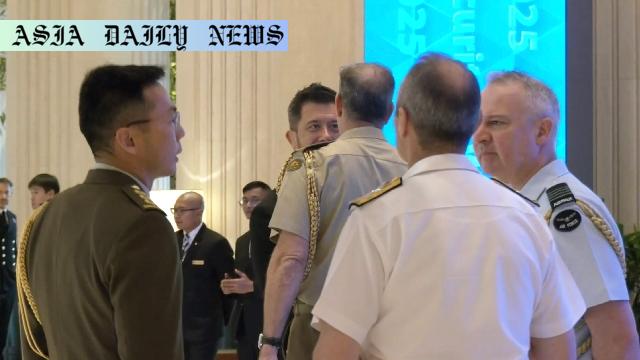Shangri-La Dialogue: US Defense Secretary Pete Hegseth meets global counterparts to address security concerns in Asia.
Shangri-La Dialogue brings together global defense officials to discuss security in Asia.
China’s absence from the event sparks analysis on its strategic intentions.
US Defense Secretary Pete Hegseth and Australian counterpart emphasize Indo-Pacific focus.
Key security issues discussed include Taiwan and South China Sea dynamics.

Shangri-La Dialogue: A Major Security Forum Addressing Asia’s Challenges
The Shangri-La Dialogue, a major security forum in Asia, convened in Singapore, drawing global attention for discussions on regional security challenges. Defense officials from Asia, the United States, and Europe participated in the forum, with US Defense Secretary Pete Hegseth taking a central role. One of the pivotal topics of discussion is the Indo-Pacific region, as countries deliberate on strategies to counter rising geopolitical tensions.
In a significant development, Pete Hegseth held a meeting with Australian Defense Minister Richard Marles before the forum’s inauguration. According to Marles’ social media post, the duo reaffirmed their commitment to the Indo-Pacific region, an area increasingly seen as a theater of strategic competition. Japan’s Defense Minister Nakatani Gen is also expected to hold discussions during the forum, underlining the multilateral efforts to ensure peace and stability in this critical area.
China’s Absence and the Impact on Dialogue
Among the notable events at this year’s Shangri-La Dialogue is the absence of China’s Defense Minister, which marks a departure from precedence as China actively participated in the past four conferences. Instead, China sent a delegation from its military academy, a move analysts interpret as a strategy to avoid direct engagement on contentious issues like Taiwan and the South China Sea. Additionally, the cancellation of a scheduled speech by China’s representative has raised questions about Beijing’s intention to sidestep escalating tensions with Washington.
This absence comes against the backdrop of heightened tariffs and unresolved trade disputes between the US and China, further complicating discussions on mutual interests in the security sphere. Observers suggest that China’s reluctance to attend could signal a broader strategy to recalibrate its focus on domestic issues or to avoid public scrutiny on issues of conflict with the US and other Asian nations.
The Importance of the Indo-Pacific Strategy
One of the recurring themes of the Shangri-La Dialogue is the strategic importance of the Indo-Pacific region. As tensions rise due to China’s assertive activities in the South China Sea and concerns surrounding Taiwan’s sovereignty, the US and its allies in the region have been reinforcing their partnership to ensure a free and open Indo-Pacific. The Indo-Pacific strategy has become a cornerstone of global security discussions, impacting trade routes, economic growth, and regional stability.
Pete Hegseth’s planned speech is expected to outline the Trump administration’s vision for addressing these security concerns and how it plans to collaborate with Asian countries to counter Beijing’s growing dominance. With defense leaders from countries like Japan, Australia, and Southeast Asian states attending, this forum serves as a unique platform to foster dialogue and cooperation to collectively address shared challenges.
Conclusion: What Lies Ahead?
The Shangri-La Dialogue remains an essential platform for addressing security concerns in the region. This year, questions surrounding the absence of China’s defense minister and the discussions on the Indo-Pacific strategy reflect the complexity of modern geopolitics. The US’s role in shaping the future of Asia’s security will be closely observed, making forums like these a critical element in facilitating transparent and collaborative efforts for peace.



Commentary
Shangri-La Dialogue and China’s Strategic Choices
The absence of China’s defense minister at the Shangri-La Dialogue this year is a point of intense discussion. It raises questions not only about Beijing’s reluctance to confront contentious topics like Taiwan and the South China Sea but also about its broader approach to global diplomacy. This move seems to align with China’s strategy to avoid discussions it may regard as counterproductive amidst its ongoing trade disputes with the United States. Analysts and policymakers alike are speculating on how such diplomatic absences could reshape the dynamics of multilateral discussions in Asia.
US Leadership and Indo-Pacific Strategy: A Test of Resolve
On the other hand, the prominent role played by US Defense Secretary Pete Hegseth at the forum underscores Washington’s unwavering commitment to the Indo-Pacific region. This commitment is crucial as the region increasingly becomes a focal point of US foreign policy. The upcoming speech by Hegseth is expected to outline critical strategies, serving as a litmus test for how the Trump administration plans to address complex security challenges. Observers are particularly keen on how Washington aims to strengthen alliances while countering Beijing’s growing influence.
Reflections on the Way Forward
The Shangri-La Dialogue is more than just a platform for dialogue; it is a reflection of the growing necessity for unity and cooperation in addressing challenges in Asia. While the forum’s discussions may not yield immediate resolutions, they serve as an essential foundation for long-term strategies. As tensions remain high, especially with China’s evolving role in global politics, it is imperative for countries to engage in open conversation, balance power dynamics, and prioritize peaceful resolutions. The outcomes of this year’s dialogue will likely have lasting ripple effects on the geopolitics of the Indo-Pacific region.